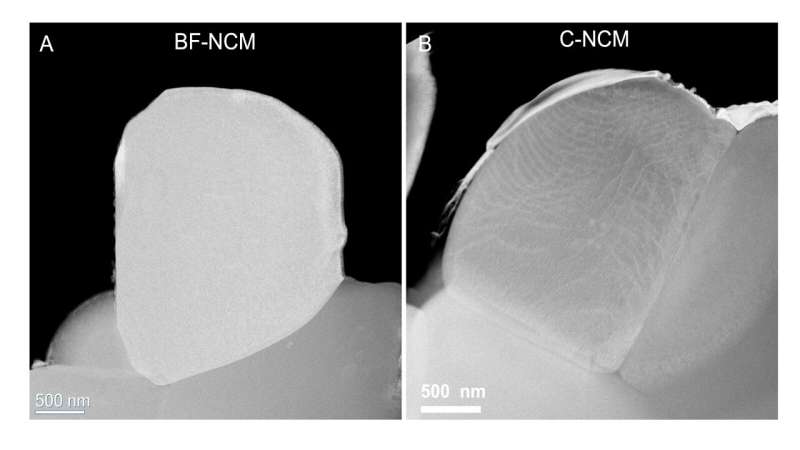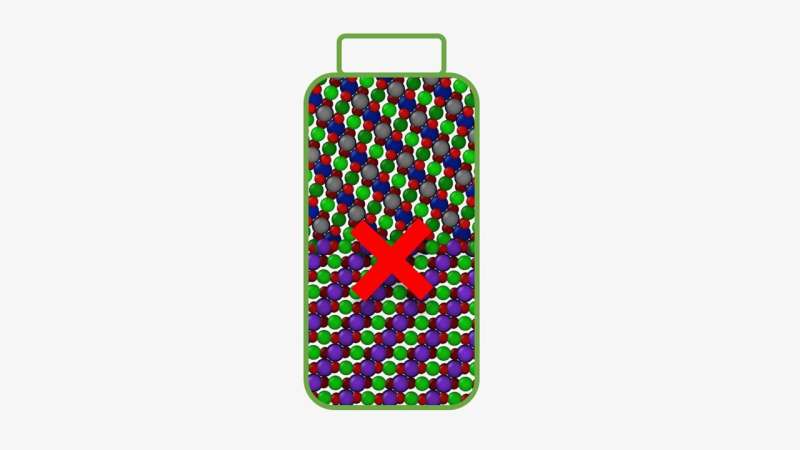
Posted on 09/08/2022 1:21:50 PM PDT by Red Badger

Single crystals of cathode material: (A) no internal boundaries and (B) internal boundaries visible. Credit: Argonne National Laboratory
Researchers at the U.S. Department of Energy's (DOE) Argonne National Laboratory have a long history of breakthrough discoveries with lithium-ion batteries. Many of these discoveries have focused on a battery cathode known as NMC, a nickel-manganese-cobalt oxide. Batteries with this cathode now power the Chevy Bolt.
Argonne researchers have made another breakthrough with the NMC cathode. The team's new structure for the cathode's micro-sized particles could lead to longer-lasting and safer batteries able to operate at very high voltage and power vehicles for longer driving ranges. A paper on this research appeared in Nature Energy.
"The present-day NMC cathode has posed a major barrier to operation at high voltage," said Guiliang Xu, assistant chemist. With charge-discharge cycling, performance rapidly declines due to cracks forming in the cathode particles. For several decades, battery researchers have been seeking ways to eliminate these cracks.
One past approach involved microscale spherical particles consisting of numerous much smaller particles. The large spherical particles are polycrystalline, with differently oriented crystalline regions. As a result, they have what scientists refer to as grain boundaries between particles, which cause cracking upon battery cycling. To prevent this, Xu and Argonne colleagues had previously developed a protective polymer coating around each particle. This coating surrounds the large spherical particles and smaller ones inside them.
A different approach to avoid this cracking involves single-crystal particles. Electron microscopy of these particles indicated they have no boundaries.
The problem the team faced was that cathodes made from both coated polycrystals and single crystals still formed cracks with cycling. So, they subjected these cathode materials to extensive analyses at the Advanced Photon Source (APS) and Center for Nanoscale Materials (CNM), DOE Office of Science user facilities at Argonne.
Different X-ray analyses were carried out at five APS beamlines (11-BM, 20-BM, 2-ID-D, 11-ID-C and 34-ID-E). It turned out that what scientists had believed were single crystals, as evidenced by electron and X-ray microscopy, actually had boundaries inside. Scanning and transmission electron microscopies at CNM verified the finding.
"When we look at the surface morphology of these particles, they look like single crystals," said physicist Wenjun Liu. "But when we use a technique called synchrotron X-ray diffraction microscopy and other techniques at the APS, we find boundaries hiding inside."
Importantly, the team developed a method for producing boundary-free single crystals. Testing of small cells with such single-crystal cathodes at very high voltage showed a 25% increase in energy storage per unit volume, with almost no loss of performance over 100 cycles of testing. By contrast, over the same cycle life, the capacity declined by 60% to 88% in NMC cathodes composed of single crystals with many internal boundaries or with coated polycrystals.

Boundaries within cathode materials are undesirable because they lead to performance degradation. Credit: Maria Chan/Argonne National Laboratory
Calculations at the atomic scale revealed the mechanism behind the capacity decline in the cathode. According to nanoscientist Maria Chan in CNM, compared to the regions away from them, boundaries are more vulnerable towards the loss of oxygen atoms when the battery is being charged. This oxygen loss leads to degradation with cell cycling.
"Our calculations showed how boundaries lead to oxygen release at high voltage and, therefore, performance decline," Chan said.
Eliminating the boundaries prevents oxygen release and thereby improves the cathode safety and stability with cycling. Oxygen release measurements at APS and the Advanced Light Source at DOE's Lawrence Berkeley National Laboratory supported this finding.
"We now have guidelines that battery manufacturers can use to prepare cathode material that is boundary free and works at high voltage," said Khalil Amine, an Argonne Distinguished Fellow. "And the guidelines should apply to other cathode materials besides NMC."
Explore further
Pivotal battery discovery could impact transportation and the grid
More information:
Xiang Liu et al, Origin and regulation of oxygen redox instability in high-voltage battery cathodes, Nature Energy (2022).
DOI: 10.1038/s41560-022-01036-3
Journal information: Nature Energy
Provided by Argonne National Laboratory
Average price of a new Battery powered car is $60,000.
ICE cars can be had for half that price. Heck one can buy a Chevy Spark for well under $20,000.
Another thing of concern is battery life and cost of replacement battery. My 11 year old Chevy HHR is running just fine with origianl battery! I want to buy a replacement battery, but the car still starts at the flick of the ignition key. So I keep postponing battery replacement.
Still need lithium and still need ions.
Advances like this are amazing. There has been more progress in Lithium battery chemistry and manufacturing in the last 20 years; than we have seen in battery storage in over 100 yrs. And it’s only getting more interesting
The Holy Grail of ultimate solutions is still out there
Meanwhile amount of charge planning and battery thermal conditioning makes existing LNMC chemistries durable. Million mile batteries are being demonstrated with maybe 12% loss of capacity.
i wonder how much effort it’d take to repurpose e-car batteries into home batterypacks for solarcells?
My wife’s 2002 Dodge Ram had a battery that lasted 19 years!.....Took it to the dealer to have it replaced and they said they were going to put it on a shelf with a sign!.................
Disclaimer: Opinions posted on Free Republic are those of the individual posters and do not necessarily represent the opinion of Free Republic or its management. All materials posted herein are protected by copyright law and the exemption for fair use of copyrighted works.